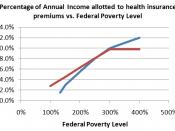The interpretation of unemployment statistics requires information on both unemployment and labor force participation. For example, if the number of people participating in the workforce decreases, and the number of people out of work or seeking work remains the same, the unemployment rate will rise. People who are unemployed have poorer physical and mental health than people who are employed. High unemployment rates usually mean that a large number of jobless workers and their families have lost their health insurance coverage through their employer. Although employees have the opportunity to continue coverage at their own cost after they lose their job, most cannot afford to do so.
As health care costs and health insurance costs rise, smaller employers cannot afford to provide insurance for their workers. In addition, larger employers may pass along any increase in premiums to their workers, making the coverage unaffordable to some. States facing budget crises can lead to cuts in the Medicaid programs and other state supported programs for the uninsured and under insured.
"Research shows that working families account for about 80 percent of the uninsured." (Owcharenko & Moffit, 2003). These are families who work but earn too much to qualify for Medicaid or state-sponsored programs, but don't make enough money to purchase either employer offered health insurance or individual health insurance coverage.
When you have a limited income, medical care is often delayed. The delay in medical care increases the risk of complications and the advancement of health problems. Therefore, when the individual finally seeks medical care, the costs are normally greater. The uninsured individual often cannot afford to pay for medical care. The under insured can afford health insurance, but the health insurance does not cover all charges and the under insured cannot afford any out-of-pocket expenses. As a result, cost shifting...


